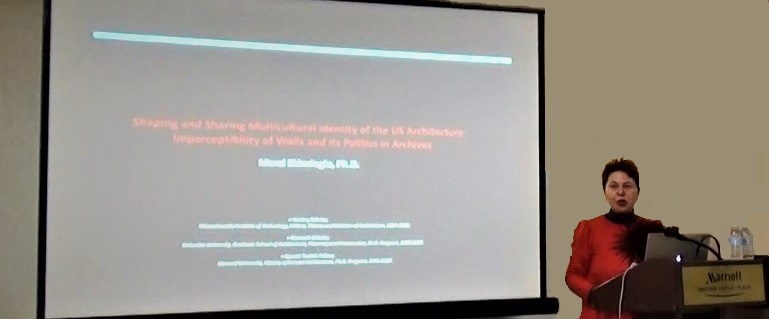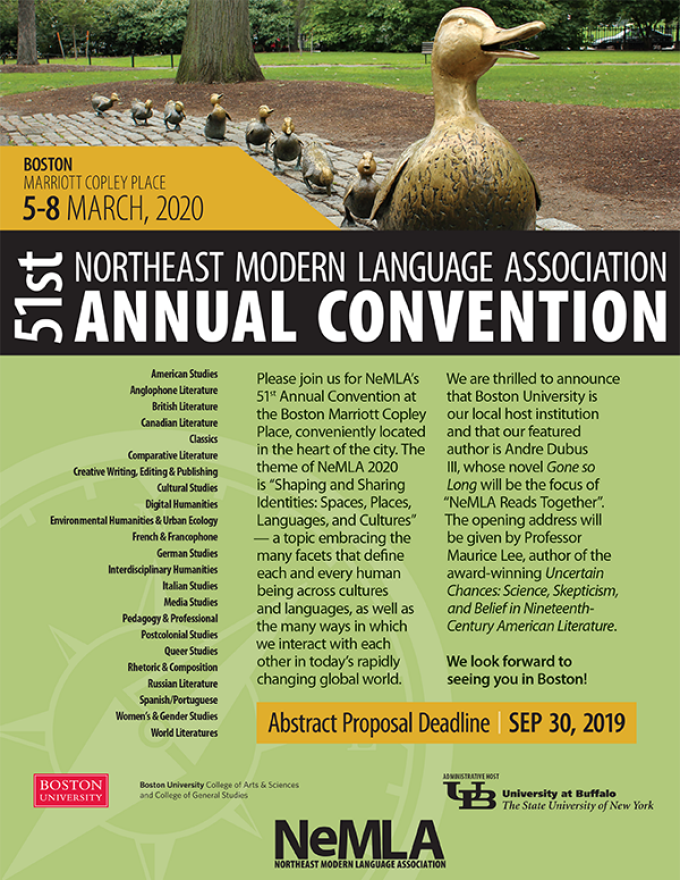.
On My Convention Presentation:
.
.
“Shaping and Sharing Identities: Spaces, Places, Languages and Cultures”:
NeMLA, Northeast Modern Language Association organized its 51st Convention
Boston University, Boston, MA, 5-8 March 2020.
.
“Shaping and Sharing Identity in Architecture: Imperceptibility of Walls in Archives” *
Meral Ekincioglu, Ph.D.
NeMLA, Northeast Modern Language Association organized its 51st Convention
Boston University, Boston, MA, 5-8 March 2020.
.
“Shaping and Sharing Identity in Architecture: Imperceptibility of Walls in Archives” *
Meral Ekincioglu, Ph.D.
.
.
.
.
As a speaker at this convention, my presentation and talk, “Shaping and Sharing Identity in Architecture: Imperceptibility of Walls in Archives” elaborated and discussed the significance of historical documentation practice in architecture to shape and share multicultural identity in the discipline and the profession with an emphasis on recent surveys, data, professional and scholarly events on the lack of diversity and inclusion in the US architecture (such as recent diversity surveys by the American Institute of Architects, National Council of Architectural Registration Boards’ data -in 2019- for women and racial minorities, “Convergence”, a two day event organized by the Harvard University-Graduate School of Design-women in design group -in 2018-, #metoo in architecture -in 2018-, Society of Architectural Historians Data Project -in 2020- to determine where and in what ways the field of architectural history is expanding or receding and to consider the structural or cultural factors behind such trends, etc.). Needless to say, historical documentation practice, its strategy and methods (in architecture) have a very significant potential a. to provide legitimate evidences for identity recognition, b. to build solid sense of identity, c. to strengthen sense of belonging for indviduals, group and communities, and d. to share personal or collective memory of each member in a (multicultural) society or community through an (internal) affirmation of their identities based on their gender, race, ethnicity, nationality, religious, etc. Based on the problem with the lack of diversity and inclusion in today’s US (multicultural) architecture, and arguments on the role of historical documentation in shaping and sharing identity (including gender, race, ethnicity, nationality, etc.), in my presentation and talk, I elaborated current situation of collective (multicultural) memory in architectural archives and collections at some pioneering schools of architecture, and its importance for “re-thinking”/”re-examining” the notion of “the citizen architect” defined by the American Institute of Architects in this Citizen TALES Commons seminar at NeMLA. According to the American Institute of Architects, “the citizen architect uses his/her insights, talents, training, and experience to contribute meaningfully, beyond self, to the improvement of the community and human condition”. As recent surveys, discussions and events on gender, race-based discrimination, #me too in architecture, etc. indicate, this (multicultural and international) professional and scholarly community firstly need to improve their “own human condition”. In order to achieve this goal, ”unity within diversity” in building collective memory can be one of the helpful start points in architecture (education) as I discussed its details in my presentation. With “unity within diversity”, I refer to “the idea of unity” based on genuine inclusion and equity for social, cultural, national, religious, political, ideological differences, and “idea of unity” based on an understanding that differences enrich human interactions (in architecture). With this “healing” (in architectural collective memory), architect can a. offer his/her knowledge and experience in advancing civic engagement and public policy “for all”, b. engage at local, state, national level in an effective way, and c. contribute to discussions on equal and inclusive citizenship for everyone. Considering the theme of the 51st NEMLA Convention, including “language”, my suggestion is “empathetic language” that demonstrates empathy, respect, tolerance to the other person, groups and communities in architecture for this goal. Finally, for “sharing” within this context, I emphasized the crucial importance of digital archives and collections with their diverse contents and scopes and open “to all”.
.
.
.
All rights reserved
© Dr. Meral Ekincioglu
.
Reproduction and distribution of any material, knowledge in this presentation and talk without written permission is prohibited. Its power point presentation and video record are available in Dr. Ekincioglu’s archive.
.
*My presentation and talk was a part of Citizen TALES Commons seminar, title “Imperceptibility of Walls”. Its chair was Dr. Vassiliki Rapti (Boston University and Harvard University); other speakers and their presentation titles were Dr. Elena Mancini on “Narrative Sensibilities, Literary Practices, and the Possibilities for Democratic Consciousness" and Kenny Yim on "Toward a Collective Consciousness in Henry James and Monique Truong". In the end of the seminar, Hannah Trivilino, Citizen TALES Commons member conducted a workshop on sharing and shaping identity, language, and participants’ reflections on all presentations. Zenovia Toloudi, co-chair could not partipate into the seminar, and Dr. Vassiliki shared her power point presentation. For the Citizen TALES Commons seminar at the 51st NEMLA Convention, please see, https://cfplist.com/nemla/Webforms/Schedule.aspx, last accessed on 3.9.2020.
.
For “the citizen architect” definition by the American Institute of Architects”, see, http://content.aia.org/sites/default/files/2018-07/Citizen_Architect_Handbook.pdf, last accessed on 3.3.2020.
.
For “the citizen architect” definition by the American Institute of Architects”, see, http://content.aia.org/sites/default/files/2018-07/Citizen_Architect_Handbook.pdf, last accessed on 3.3.2020.
My presentation at the 51st NeMLA Convention: Shaping and Sharing Identity in Architecture: Imperceptibility of Walls in Archives, Boston, MA, March 8th, 2020. (Citizen TALES Commons seminar).


The 51st NeMLA Convention: Shaping and Sharing Identities: Spaces, Places, Languags and Cultures, Boston University, Boston, MA, 5-8 March, 2020.
For more, see:
https://www.researchgate.net/profile/Meral_Ekincioglu/publications
https://mit.academia.edu/MeralEkinciogluPhD